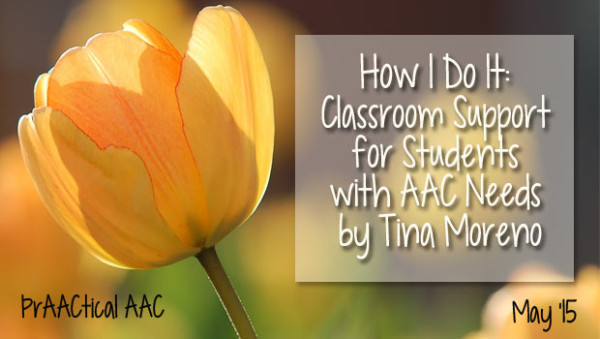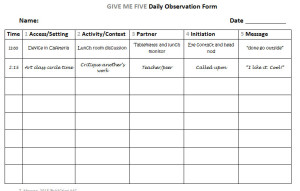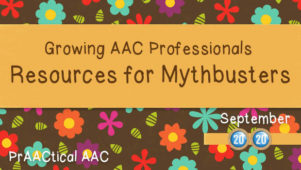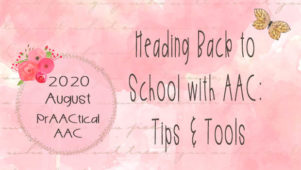How I Do It: Classroom Support for Students with AAC Needs by Tina Moreno

We are fortunate to have a return visit from Tina Moreno, who brings her experiences both as an SLP and also as a mom of a teenager who has used AAC for most of his life. In this post, Tina  shares some of the strategies that she has used to support AAC students in their classrooms. If you are a school-based SLP, don’t miss Tina’s classroom observation form for gathering data on how AAC is being used in various activities and lessons.
shares some of the strategies that she has used to support AAC students in their classrooms. If you are a school-based SLP, don’t miss Tina’s classroom observation form for gathering data on how AAC is being used in various activities and lessons.
GIVE THEM FIVE
As an SLP in the school setting, helping teachers support students in the classroom can be a big challenge. While we can see students making progress in our therapy sessions, it can be difficult to get the same results in the classroom. An important role of the SLP is to collaborate with teachers to help students generalize these skills in conversation with their peers and other adults throughout the school. These are five strategies are designed for SLPs to help classroom teachers encourage and motivate their students to practice using their voices beyond the therapy room:
- Give the student access to words all the time
It can be nerve wracking for adults to worry about communication systems in accident-prone settings such as playgrounds, gym class and the cafeteria. While some communication systems are more expensive than others, every voice is priceless. Still, children need to have access wherever communication happens. For typical communicators, that’s everywhere and we should have the same expectations for children who use AAC. That means getting creative, especially for children who are ambulatory. Ideas include adding a shoulder strap to a PECS book or fashioning a mobile cart to transport an AAC device independently. Teams should develop a plan to ensure the student has access to the communication system all the time.
- Keep things motivating
In the school setting – and everywhere else for that matter – there is a great deal of emphasis placed on encouraging ALL students to answer questions. Generally, children who use AAC are often in danger of becoming RESPONDERS. They learn how to navigate their communication systems to answer the questions posed to them, but they often struggle to initiate conversation, ask a question or just interject something spontaneously. Adults, including teachers and para-educators, should be encouraged to model communication with the student’s system for a variety of purposes. SLPs will likely need to model for the other adults as well. The more familiar the entire team becomes with a child’s communication system, the easier and more natural it becomes for everyone.
The key is developing motivating activities that encourage social communication and language learning. This may include shared reading activities and many others, including:
- 20 Questions
- Jeopardy
- Poem writing
- Treasure hunts
- Rory’s Story Cubes (storycubes.com)
- Apples to Apples
- Barrier activities using Legos, blocks and other building materials
- Reading and publishing books on Tar Heel Reader (tarheelreader.org)
- Hedbanz
- Create many opportunities across settings with a multitude of communication partners
It takes a village. A child who uses AAC to communicate must practice with a wide range of communication partners in many, many settings. That means that the training SLPs need to provide must extend beyond the classroom. It should include bus drivers, cafeteria personnel, recess monitors, librarians, custodians, principals, nurses, secretaries and more. It is not necessary to spend a great deal of time teaching all these individuals the ins and outs of each student’s individual communication system. However, every adult (and peer, for that matter) should learn the basics of communicating with an AAC user, such as:
- Be patient
- Ask open-ended questions
- Wait (more on this later)
- Always presume competence and intelligence
- Speak directly to the individual, not through a nearby adult or caregiver
Look for opportunities for your student to get involved in the school community using his own voice in different ways. Ensure that your student gets turns making announcements, reciting the Pledge, performing in school plays, introducing band and choir performances, delivering the morning news, working in the school store, volunteering in the library, sharing a daily joke and delivering mail to the office. The more practice, the more competent the student will become. An equally important side effect of all this practice will be an increased comfort level and familiarity of the entire school population when it comes to listening to your student and responding to what is said.
- Wait for it
Students who communicate with AAC need time to formulate what they want to say. In the fast-paced classroom setting, it can be challenging for teachers to provide the wait time that is needed. Peers often want to “help” and eagerly jump in to answer for their friends. Help develop a system for your students to let their communication partners know they have something to say and need time to speak. This might be a prestored message such as “Give me a minute to say something” or a simple gesture to ask for more time. One friend utilized a switch to activate a blue light to raise his hand in class. When one student glanced at her PODD book, it was always presumed that she had something to say and that she needed a communication partner to sit down and help her formulate her message.
Teachers must sometimes create time for students to formulate their messages so that their words could be delivered in “real time” when called upon. For example, prior to discussion time, one teacher assigned questions to students by pulling out Popsicle sticks with individual names written on them. After the questions were assigned, all of the students were given time to prepare their answers before responding. Members of the team should brainstorm on ways to provide an appropriate pace for each student.
- Respond to communication efforts
All children communicate in many different ways and AAC communicators are no different. It often takes time for children still learning to use their alternative voices to truly understand the power of their communication. It is important for everyone in the school setting to acknowledge every communication attempt. This is another example of the importance of the team effort in the hectic classroom setting. Teachers need to rely on the ears and eyes of other adults and peers in the classroom in order to acknowledge and respond to all the ways a child communicates.
Let’s face it. We can’t always be in the classroom to observe our students. At the same time, we need to collect data regarding their initiation of communication and collect language samples across settings and communication partners. The image below is of an observation form designed specifically for early communicators. This form can be completed by any of the adults working with your student. It can be completed daily or on a schedule determined by the team. Click on the image (or visit the AAC eToolbox, under AAC Tools) to download.
::::::::::::::::::::::::::::::::::::::::::::::::::::::::::::::::::::::::::::::::
Tina Moreno is an SLP with a love of AAC. She worked with children with complex communication needs in the school setting for five years and is now working in an outpatient hospital setting where she introduces many of her patients to low tech and high tech voices. She is inspired every day by her 15-year old son, Mateo, who has been communicating with a Dynavox since the age of 4. She is also co-director of Camp ALEC, a week-long, residential literacy camp for children who communicate with AAC due to physical disabilities. Camp ALEC, with experts Drs. Karen Erickson and David Koppenhaver, will be offered August 9-15 at Indian Trails Camp in Grand Rapids, Michigan. Families can find more information about Camp ALEC or apply by visiting www.campalec.wordpress.com.
Filed under: PrAACtical Thinking
Tagged With: assessment, classroom, forms, implementation ideas, intervention, resources, Tina Moreno
This post was written by Carole Zangari





